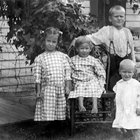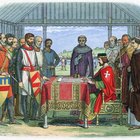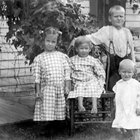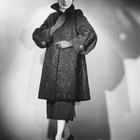
What is now considered standard kids clothing would have been confusing to people who lived during the 1800s. In that time, children wore specific types of outfits at certain ages. By looking at the way a child dressed, a person could tell approximately how old the child was as well as his social status. This was especially true in Europe and in larger cities in the U.S. Pioneer children did not have all of the same conventions, but guidelines were still followed.
Infant Wear
Very young infants wore what are referred to as long clothes. This was a dress that was longer than the baby, usually white in color. The extra length of the dress could be folded up for extra warmth or to protect the legs. When the baby got more active, the clothing got shorter to allow for more freedom of movement. These were then referred to as short clothes. The short clothes were standard until the child became a toddler.
Toddler Wear
Toddlers of both sexes wore dresses. The fancier the dress, the more money and social position the family had. These dresses included the wearing of petticoats to fill out the skirt. Cotton was the most common fabric for clothing to be made of, although wealthy families often would dress their children in silk. Fabric colors were bright, and patterns were cheerful. Often, small white caps were worn with the dresses to complete the look. It is not until after the toddler years that children dressed in accordance with their gender.
Boys
Breeching is known as the time when a boy transitioned from wearing dresses to wearing trousers. Even though this usually happened when the boy was about 4 years old, it was considered a rite of passage into manhood. The first suits boys wore were called skeleton suits. These suits were tight to the body, and the pants attached to the jacket with buttons and worn with a white blouse. After that, and up until the 1870s, boys wore long pants with tunics or other shirts and suspenders, while adult men wore knee breeches. After the 1870s, boys wore knee breeches and grown men wore long pants. Fabrics for boys' clothes were often cottons, wools and some silk.
Girls
Girls continued to wear dresses, with age dictating the length of the skirt. Until a girl was approximately 12 years of age, her skirt came to her knees. From that age until 17, her skirt reached her ankles. After that, women wore floor-length dresses. The dresses for all ages were generally heavily decorated and made of cotton, silk, sateen, fine wool and poplin. Hats were a must and also were very ornate. Girls of poor families followed the same hem guidelines, although her dresses were not as ornate and usually made of thinner cotton, linsey and wool.
Related Articles

Children's Clothing From the 1920s

Children's Clothes in the 1600s

Children's Clothing in the 1900s

School Clothes in the 1900s

Kids' Clothing During the Medieval ...

Children's Clothes in 1915

Children's Clothes in 1910

Irish Clothes of 1850

Fashion for Children in the 1960s

Gender Differences in Children's ...

What Teenagers Wore in the 1940s

Farmer's Wife's Clothes in the 1800s

Wedding Dresses of the 1920s, 1930s & ...

What Did Teenagers Wear in the '60s?

How to Dress Like a Pioneer

1958 Men's and Women's Dress Styles

Traditional Roles of Men & Women in ...

1950s Clothes for Children

School Uniforms in the 1940s

How Did Teenagers Dress in the '60s & ...
References
Writer Bio
Elizabeth Sobiski has been writing professionally since 2005. She provides businesses such as Burdick and Lee Galleries, Clearwater Fishing Charters and Read Finder with custom content to keep their digital and print media fresh, informative and directed to their target audience. Sobiski holds a Bachelor of Arts in English from Roosevelt University in Chicago.
Photo Credits
little girl image by NiDerLander from Fotolia.com